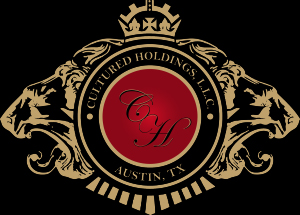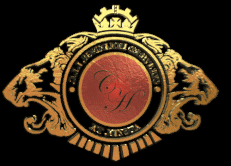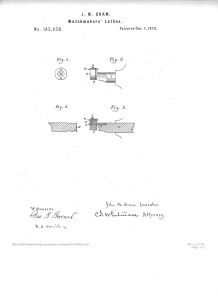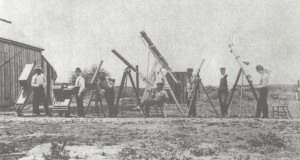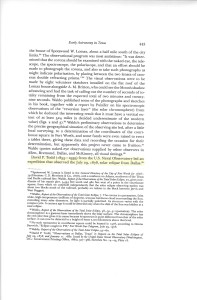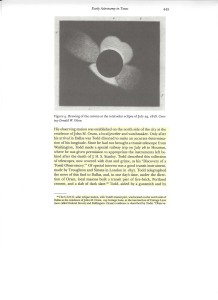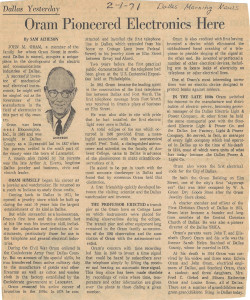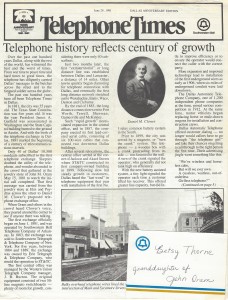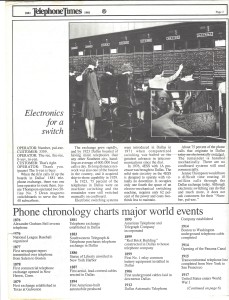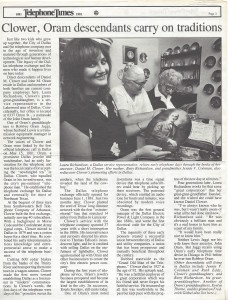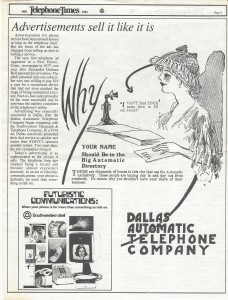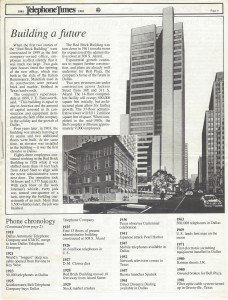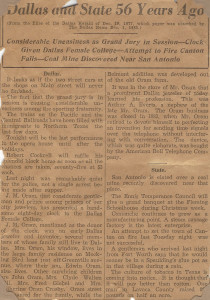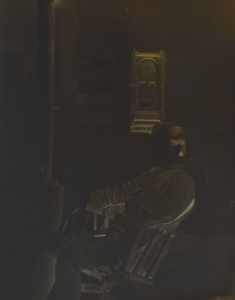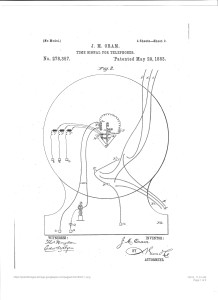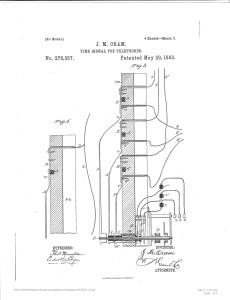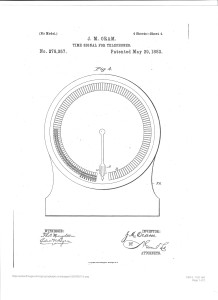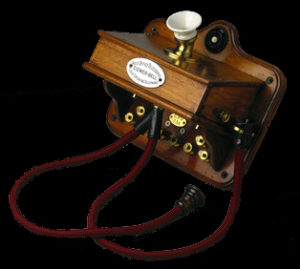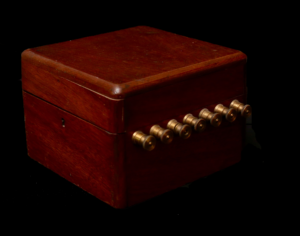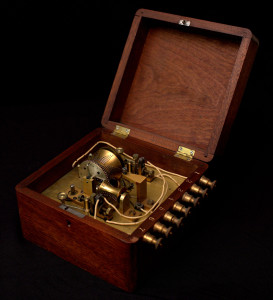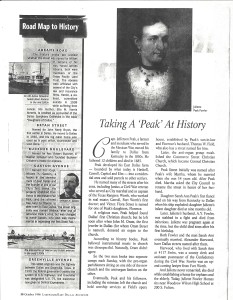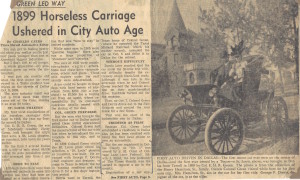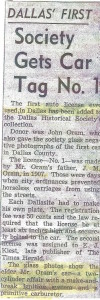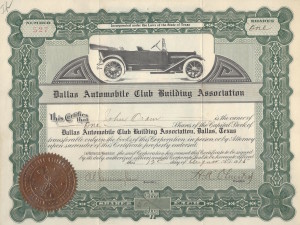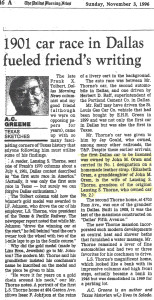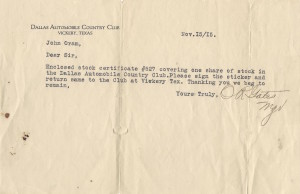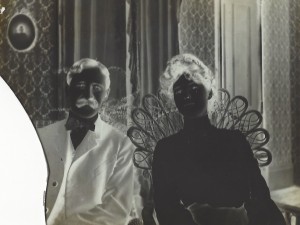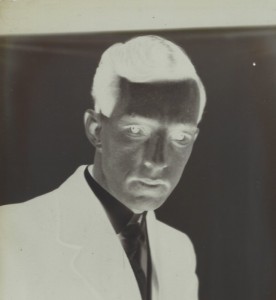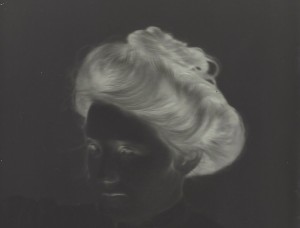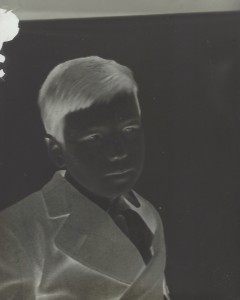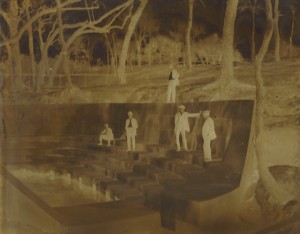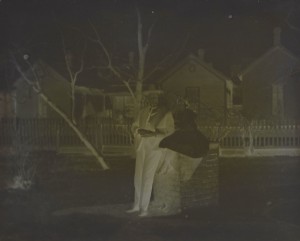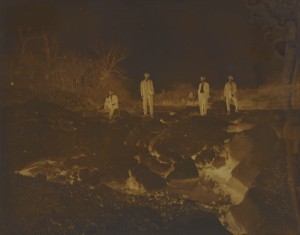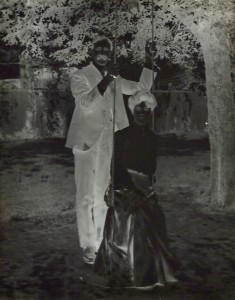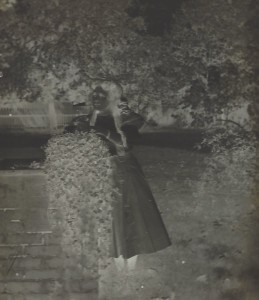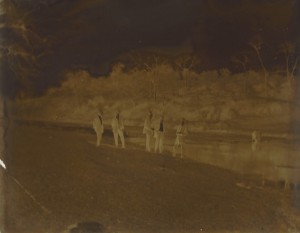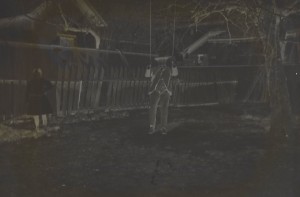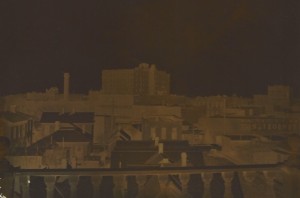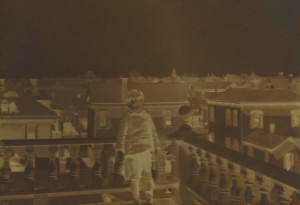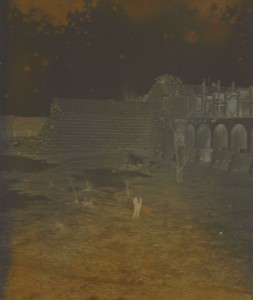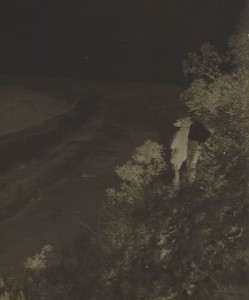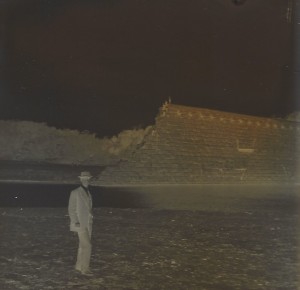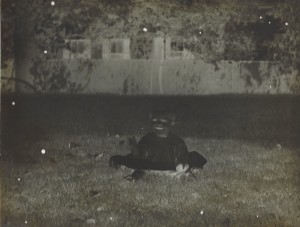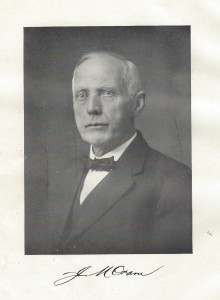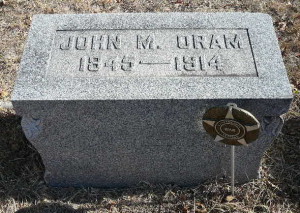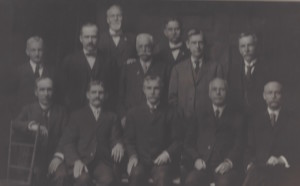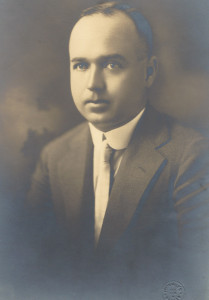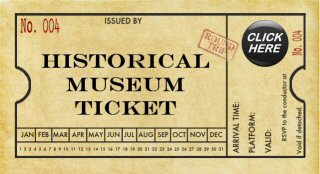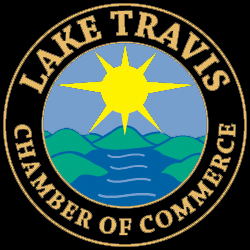1873 Jewelers Lathe
THIS PAGE IS CURRENTLY BEING UPDATED!
John M Oram was a jeweler by trade. This is the accompanying description of the illustrated lathes plate. JM Oram invented a lathe that had an extendable arm secured in position therefore the watchband could be rotated and the lathe remain stable but still able to rotate staves and pinions to be cut or polished. This improved the then-current lathe by having the tension of the motor operating on the lathe rather than the object being worked on.
Illustrated Patent No.143,458. Submitted by John M Oram. Watchmakers’ Lathes. Patented October 7,1873. Witnessed by G Howard and H Daniels. Signed by J Oram, Inventor, and C Whitman, Attorney
1878 Oram’s Role in Early Astonomy
The July 29, 1928 Dallas Morning News featured a front page headlines and an accompanying article celebrating 50 years since the total solar eclipse seen in Dallas. Eyewitness accounts accompany the description of this historical event. What makes this event stand out is that Dallas was a strategic observation point for the official astronomers. John M Oram’s residence with his accurate time recording devices and telegraph was the location where the great minds met to observe. What makes this event stand out in history is that was the first time when a widely viewed occurrence, such as this total eclipse of 1878, could be described and compared in real time in two difference places via the telegraph.
(below) – “Early Astronomy in Texas”- This paper details the beginnings of Texas astronomy. First the early findings of meteorites are described by both Native Americans as well as Texans which lead to the founding fathers of astronomy in Texas. The early astronomers were not scientifically trained, but harboured a deep passion for the skies that they studied. The earliest scientifically trained astronomers in Texas were not local, but rather out of state visitors coming to observe events such as comets, solar flares, planetary eclipses and meteor showers. John M Oram played a role in this phase of early astronomy in Texas as his private residence served as an official observation location for the July 29, 1878, total solar eclipse that was coordinated by Dr. David Todd from the US Naval Observatory. For the latter part of the century and the early part of the 20th century there was a lull in astronomy, save for a handful of amateurs. The passing of the 1910 Halley’s Comet only attracted the interest of one teaching scientist in Dallas whereas most of the general public remained disinterested or even fearful. Breaking up the doldrums of Texas astronomy between 1913-1915 a Kerrville amateur astronomer recorded 341 variable star observations and sent them to the American Association of Variable Star Observers. The Great Depression severely curtailed opportunities for astronomers but the AAVSO still did include entries during and after the war. In 1926, a wealthy rancher and banker bequeathed to the University of Texas over a million dollars for the establishment of an astronomical observatory. This propelled Texas into the modern astronomical era. Southwestern Historical Quarterly
1881 Electronic Pioneer
This article celebrates 100 years of the telephone in Dallas. John M Oram is credited with making the first phone call in Dallas on May 15, 1881, from his jewelry store on Elm Street across the street to Daniel Clower’s proposed telephone exchange office. In amazement, people looked around the corner inside the shop when Clower’s voice was heard through the phone, checking to see if he were inside the building instead of across the street. This call ignited the boom for telephones not only in Dallas, but across the state. The rapid growth of this new necessity brought with it new employment positions and new companies. Aerial cables were soon seen overhead which then gave way to underground wires. Four years before Clower’s death in 1927, there were 50,000 telephones in Dallas- the most of any southern city. Telephone Times, a Southwestern Bell publication. June 28, 1981.
Telephone Times, June 28, 1881
The birth of the Telephone Exchange in Dallas was in 1881 at John M Oram’s jewelry store where he and another 40 of Dallas’ residence gathered to witness the first initial call from the jewelry store to the proposed phone exchange office across the street.
JM Oram was recognized in this newspaper article for having donated an eight day clock to the Dallas Female College. He was noted as being of the highest caliber of jewelers in the city of Dallas. The article pointed out that Oram Road was named for his family and that the Belmont addition of town was formed on acreage having belonged to the family farm. Oram was written as having been a prominent jeweler before retiring to perfect his invention for sending time signals over the telephone without interrupting the speaker that was later bought by American Bell Telephone Company. From the files of the Dallas Herald of December 19, 1877 which paper was absorbed by the Dallas News December 1, 1885.
right– This glass negative shows the clock on the wall in his home, behind Oram.
1885 Oram Time Machine
These are the four illustrated plates for the patent of John M Oram’s Time Signal for the Telephone. Patent No. 278,357. Patented May 29, 1883. Signed by witnesses T Houghton and E Byrn, inventor J Oram, and his attorney.
Oram Time Signal Transmitting System
The last of John M. Oram’s improvements to his “Time Machine” Patent # 328,055, October13, 1885. This invention used a series of electrical pulsations to allow the caller to get the accurate time. A standard-time clock in Mr. Oram’s home controlled the invention. The orginal invention was patented in May 29, 1883; Patent # 287,357. The first improvement to the patent was made October 30, 1883 Patent # 287,710.
1516 Elm st. Dallas TX
In this newspaper blurb, an announcement decried the “largest and most fashionable stocks of piece goods” arrived in Dallas to occupy a space in the building owned by JM Oram. Dallas Daily Herald. August 25, 1880.
As the Oram Building was well known, it naturally became a landmark. This advertisement tells ladies to shop for their fabric goods with Mrs Chestnut, next door to the Oram building. Dallas Daily Herald. June 3, 1881.
Organ church
Capt Jefferson Peak donated money to build a church to hold Dallas’s first Christian congregation, with other contributing materials and land. However, when the members assembled, Peak was insulted by church secretary John Oram’s donated organ, whose music Peak considered profane and unauthorized from the Bible. In its new facility the congregation divided into organ and anti-organ factions sitting opposing one another. Eventually the anti-organ supporters, including Peak, left the new church to build another new one where any musical instruments were forbidden.
“Taking a ‘Peak’ At History” focused on the personal history of Captain Jefferson Peak. One of his defining moments in his life came when he helped found Dallas’ first Christian Church. However, he soon left when John Oram, the first Dallas jeweler, donated an organ to the church. Peak believed instrumental music to be sacrilegious, which obviously Oram did not share those same beliefs. Each Sunday after, the two men and their following parishioners segregated on either side of the church- organ supporters and anti-organ supporters. Peak and his followers, which included the minister, finally went their separate ways and held services at Field’s opera house, which was established by Peak’s son-in-law. Lakewood/East Dallas Advocate. October 1996.
#1 License Plate in Dallas
This article looks back on the first cars in Dallas. October 5, 1899, saw the first horseless carriage when chief designer and engineer George Dorris delivered his new St Louis Phaeton to Colonel Green in Terrell. Together the two men drove the 30 miles into Dallas. October 7, 1899, the two men raced several laps around the Dallas Fair Grounds. While Col. Green can lay claim to being the first man in Dallas to own a car, John M Oram had the distinction of having the first registered car in Dallas “No. 1”.
Dallas Historical Society proudly announced in this article that John Oram had donated the first ever drivers license in Dallas county to their archives. John Oram’s father, John M Oram, had been the original owner of that license, in 1907. Along with the self designed “No. 1” metal license, the younger Oram also donated pictures of his father’s 2-cylinder 1907 model car.
This original certificate showed John Oram entitled to one share in the capital stock of the Dallas Automobile Club Building Association. Dallas, TX. August 12, 1915.
The Oram’s remained heavily involved in the Dallas automobile scene in 1915. These 3 bank notes from the American Exchange National Bank show John Oram’s purchase of $50 for 1 share of Dallas Auto Country Club Stock on July 29, 1915, $4 to be paid to the Dallas Automobile Country Club on August 4, 1915, and $6 to be paid to the Dallas Automobile Country Club on October 8, 1915.
“1901 car race in Dallas fueled friend’s writing”- please see LS Thorne
The Dallas Automobile Country Club sent John Oram his stock certificate on November 15, 1915, with the reminder to sign the sticker and return it.
Oram Family Glass Negatives
Texas Historical Encyclopedia
excerpt:
John Milton Oram annotated biography and lifetime events: This is a written biography of John M Oram’s family history, which features his prominence as an inventor as well as a promoter of the telephone and general electronics. His improvements to the phone include a time signal and the automatic signal heard when a land line is first lifted. Because of his hand made time signal clock keeping impeccable time and time recording devices, his house was selected as the viewing point when there was a total eclipse of the sun. Oram is also known for erecting the first skyscraper in Dallas. He was respected in the city, active in church, and was effective in charities and business rather than conspicuous.
It was his genius as an inventor of mechanical and electronical devices, which raised the late John M Oram above the commonplace plane of life and made his career one of distinctfull usefulness to his generation, and makes his name one that should long be honored in his home state.
John M Oram was born near Bloomington in Monroe county, Indiana, April 29, 1845. He was a son of John T and Elizabeth (Dyer) Oram. His father, a native of Virginia, who lived for a number of years in Monroe county, Indiana, brought his family to Texas in 1857 and located at Lancaster in Dallas county. His wife was a native of Asheville, North Carolina.Another of his family is Miss Bessie Oram, who has lived for many years with her brother John and family in Dallas. She is a writer or fine accomplishments and has long been a contributor to local publications of literary nature.The late John M Oram was married in 1878 to Miss Sarah Helen Stanford, of Dallas. She was born in Russell county, Alabama, daughter of Thomas William and Rebecca Jane (Poitevant) Stanford. Her father was born in Pittsburg, Pennsylvania, and her mother, who was of French Huguenot descent, was born at Wilmington, North Carolina. Thomas W Stanford was one of the owners and founders of the Columbus Iron Works in Georgia, one of the early industrial establishments of the city, and was a leading spirit in the up building of the locality in its early years.
Before the war John M Oram cam to Texas, locating in the Southern part of Dallas county, from which place he enlisted in the Confederate Army, but on his account of his previous experience was soon transferred from active military service to the equally important work of manufacturing arms, cotton and woolen cloth, etc., in the Confederate government’s work at Lancaster. The ancestors of both Oram and Stanford have been pioneers in the new countries, and both are strong races of people.They also have always been devoutly religious people, and have taken a leading part in practical Christianity and done much to influence others in the good works. Besides his widow Mr. Oram is survived by the Following children: Edwin Oram, an electrical engineer of Dallas; John Oram, also and electrical engineer; Stanford Oram, who is a student; and Mrs. Fred C Giebel and Misses Louise and Katherine Oram, all of Dallas.
The late John M Oram came to Texas with his parents when but a boy, the family locating at Lancaster in 1857. His mechanical tastes and original ability were manifested during his youthful years, and found an outlet in his choice of a vocation as jeweler and watchmaker. In order to learn his trade under competent instruction he traveled by stagecoach from Lancaster to New Orleans, and then by steamboat up the Mississippi until he arrived in Indiana, and studied the jeweler’s trade under an uncle. After some years of experience he returned to Dallas in 1871, which city remained his home for over forty years until his death. The first ten years were spent in the jewelry business, and he built up the largest establishment of its kind at the time in Dallas county.
While successful as a businessman, the dominating fact in Mr. Oram’s life was his inventive skill, was almost constantly employed in the study, adaption and perfection of instruments of varied classification, but particularly for use in the telephone and general electrical industries. Mr. Oram constructed and installed the first telephone in Dallas, a line extending from his residence on Cottage Lane to his place of business on Elm Street. That was in 1878, and only two years before, at the Philadelphia Centennial, the first practical public demonstration of the original telephone instrument was made, so that Dallas, as a result of Mr. Oram’s work, was one of the first cities in the country where the telephone was operated as a useful facility for communication.
In 1880 Professor Todd, the distinguished astronomer and scientist of Amherst College came to Dallas to make observations of the total eclipse of the sun. He inquired as to who had the most accurate time in the city, and was referred to Mr. Oram. As a result of their subsequent intercourse a friendship sprang up between the two men, and Professor Todd mentions Mr. Oram in his subsequent book containing the results of his observations in Dallas. Professor Todd erected upon the lawn at Mr. Oram’s residence, a transit pier, which still stands there, and upon which as a base were erected the instruments for taking the observations during the eclipse. Professor Todd paid Mr. Oram the highest compliments for the latters skill and accuracy in marking time-recording instruments. His proficiency in this respect was indeed remarkable.
Mr. Oram’s retirement from the jewelry trade in 1885 was occasioned by his desire to devote himself to perfecting and manufacturing a telephone time signal, which he had invented and sold to the American Bell Telephone Company in Boston. This instrument was very complicated, and in response to the urgings of the telephone people, he became general manager of the company, which manufactured the device. The original time signal clock, which he invented now stands in the hall of his home on Cottage Lane, ticking away, as industriously and as accurately as at the time the model, made by his own hands, was completed years ago. By this device telephone subscribers were enabled to obtain the time by lifting the receiver and hearing an automatic signal. The device was used by the American Bell Telephone Company in Boston, but with the coming of conditions which placed clocks or other timepieces within the reach of almost every one, the general use of the signal by telephone companies was abandoned. Mr. Oram also invented a device which eliminated the old crank system of ringing the telephone, and perfected other inventions to improve services. He invented a testing set for locating and testing leaks on telephone and electric wires, and another electrical device for bank protection against burglars.
Within a few years Mr. Oram returned from Boston to Dallas and became general manager of the Dallas Power and Light Company. At other times he was manager of the Standard Electrical Light Company and of the Dallas Ice Factory, Light and Power Company. Thus he was manager of every electrical light company which has operated in Dallas up to the present time. He was at one manager of an independent long-distance telephone company that established in Dallas.
For some years, during the late ‘80s and the early ‘90s, Mr. Oram was city electrician of Dallas and it is said that during his official service he gained the admiration of all his fellow officials and of every person engaged in the electrical business in Dallas. While city electrician he wrote and published all the rules and regulations for the city’s electrical department.
Among numerous other useful devices invented and improved by him, Mr. Oram perfected a jeweler’s lathe which greatly facilitated work in that trade. He invented and perfected various devices for the telephone, telegraph, talking machines, and other electronically controlled instruments. It is said that a number of years before the linotype machine was known or any other practical device had been invented for mechanical typing, Mr. Oram had given some thought to such a machine, but the business responsibilities which took him away to Boston interfered with his putting his ideas into practice. He also built the Oram building on Elm street, now occupied by W.A. Green & Company. That was one of the first “skyscrapers
Related searches:
